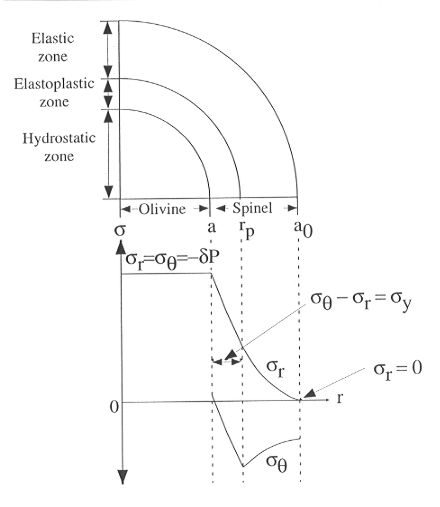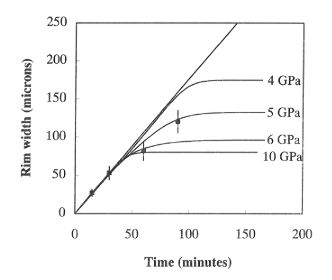

The mechanical behavior of materials under mantle conditions is difficult to study quantitatively using existing experimental techniques (see sections 3.1e,f). In order to determine the strength of wadsleyite and ringwoodite, the high-pressure forms of olivine, we are exploiting the interaction between rheology and reaction kinetics. When olivine transforms to wadsleyite or ringwoodite, the large negative volume change (6-8%) induces elastic strain energy, which reduces the driving force for growth and therefore decreases the growth rate. Relaxation of this strain energy by viscous or plastic flow allows reaction to proceed. In a simplified system with spherical geometry, where the high-pressure phase grows as a rim on the outside of an olivine single crystal, the stress relaxation and hence rate of growth is controlled primarily by the mechanical properties of the high-pressure phase. This geometry is utilized in multianvil experiments at 17 GPa, 900-1300°C, using spherical olivine crystals embedded in a NaCl pressure medium.
Growth of reaction rims on the samples has been modeled using theory
developed for misfitting inclusions. The state of stress and strain of
the system are monitored as a function of time as elastic strain energy
accumulates. When the differential stress in the rim exceeds the yield
strength, plastic yielding occurs, reducing the strain energy (Fig. 3.1-8).
In this way, growth kinetics can be modelled as a function of time. Model
fits for growth rate data at 1100°C and 17 GPa provide an upper constraint
for the yield strength of wadsleyite of 5 GPa
 |
|
Fig. 3.1-8: Schematic representation of the elastoplastic model showing
development of radial and tangential stresses as a function of radius in
olivine transformed to a rim of wadsleyite. A zone of elastoplastic deformation
develops in the rim when the differential stress  exceeds the yield strength (
exceeds the yield strength ( ) of
the wadsleyite. The stresses in the relic olivine are hydrostatic. ) of
the wadsleyite. The stresses in the relic olivine are hydrostatic.
|
at a strain rate of 10-6 s-1 (Fig. 3.1-9). This compares to a yield strength of 1 GPa for olivine at the same conditions, calculated by extrapolating the flow-law for low-temperature plasticity.
Work is in progress to characterize the deformation mechanisms of wadsleyite
and ringwoodite in the experiments. Initial results suggest that dislocation
climb is rapid in wadsleyite at 1100°C, consistent with results from
previous deformation experiments (see Annual Report 1997). However, even
if climb is rapid, deformation may be controlled by glide of partial dislocations
to form (010) stacking faults, which would be consistent with a low-temperature
plasticity mechanism.
 |
Fig. 3.1-9: Growth distance as a function of time at 1100°C,
17 GPa. The straight line represents the case of interface-controlled growth
unaffected by strain energy. The curved lines show model fits to the data
assuming different values for the yield strength of the wadsleyite rim. |

Tel: +49-(0) 921 55 3700 / 3766, Fax: +49-(0) 921 55 3769, E-mail: bayerisches.geoinstitut(at)uni-bayreuth.de
 Previous page
Previous page